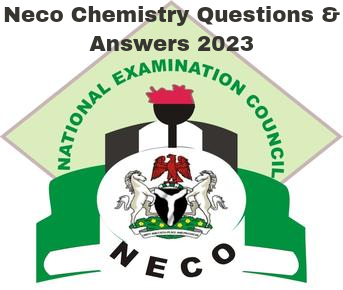How to Pass NECO Chemistry: Objective and Essay Questions and Answers Explained (With Examples)

Chemistry is one of the core subjects in the Senior Secondary Certificate Examination (SSCE) administered by the National Examinations Council (NECO). It is a required subject for students who wish to study science-related courses at a higher institution. As a result, it is important to properly prepare for the NECO chemistry exam and score high marks.
In this article, we will provide you with some helpful information on how to prepare for the NECO chemistry exam, as well as some sample questions and answers for both the objective and essay sections. We will also give you some helpful tips on how to answer the questions correctly and avoid typical mistakes.
What is NECO Chemistry Exam?
The NECO chemistry exam is a test of your knowledge and comprehension of the fundamental ideas and principles of chemistry. It covers subjects like organic chemistry, physical chemistry, analytical chemistry, chemical reactions, the periodic table, and environmental chemistry. It also covers topics like atomic structure and chemical bonding.
The NECO chemistry exam is divided into two sections: Paper 1 consists of 60 multiple-choice questions that must be answered in one hour. Paper 2 contains two sections: Section A (Theory) and Section B (Practical). Section A contains six essay questions, four of which must be answered in two hours. Section B contains three practical questions, one of which you must answer in one hour.
The NECO chemistry exam has a total of 200 marks. Paper 1 carries 60 marks, Paper 2 Section A carries 80 marks, and Paper 2 Section B carries 60 marks. To pass the exam, you must score at least 50% on each paper.
Related Article: Lester B. Pearson Scholarship in Canada 2023-2024 [ Fully Funded]
How to Prepare for NECO Chemistry Exam?
You must do the following to properly prepare for the NECO chemistry exam:
- Thoroughly study the NECO chemistry syllabus and understand the objectives and outcomes of each topic.
- Review your class notes and textbooks on a regular basis to ensure you understand the key concepts, formulas, definitions, laws, and equations.
- Practice answering past questions and answers from previous years’ exams and mock tests. You can get them online or in bookstores.
- Revise your weak areas and clarify any uncertainties with your teachers or classmates.
- Attend revision classes or tutorials, if possible, and learn from your instructors’ feedback and corrections.
- Prepare your practical materials and equipment in advance, and become familiar with the procedures and safety rules.
- Before the exam, eat well, sleep well, and stay healthy. Avoid stressful situations and distractions that can affect your concentration and performance.
Related post: How to Apply for Student Loan in Nigeria
NECO Chemistry Objective Questions and Answers 2023
The objective section of the NECO chemistry exam tests your ability to recall facts, recognize concepts, apply principles, analyze data, and solve problems. For each question, you must select the correct option from four alternatives (A, B, C, or D).
Here are some sample objective questions and answers for the NECO chemistry exam 2023:
- Which of the following elements has the highest electronegativity?
A) Fluorine
B) Chlorine
C) Oxygen
D) Nitrogen
Answer: A) Fluorine
2. What is the name of the compound with the formula CH₃COOH?
A) Methanoic acid
B) Ethanoic acid
C) Propanoic acid
D) Butanoic acid
Answer: B) Ethanoic acid
3. What is the oxidation number of sulfur in SO₄²⁻?
A) +2
B) +4
C) +6
D) +8
Answer: C) +6
4. What type of reaction occurs when zinc reacts with hydrochloric acid?
A) Combination reaction
B) Decomposition reaction
C) Displacement reaction
D) Neutralization reaction
Answer: C) Displacement reaction
5. What is the empirical formula of benzene?
A) CH
B) CH₂
C) C₂H₂
D) C₂H₄
Answer: B) CH₂
See Also: How to Borrow Money from Opay
Tips for Answering Objective Questions
To answer the objective questions correctly, you need to follow these tips:
- Carefully read the question and fully understand what it is asking.
- Remove any options that are obviously incorrect or irrelevant.
- Choose the best option that fits the question based on your knowledge of chemistry and logic.
- If you are not sure of the answer, make an educated guess based on clues from the question or the options.
- Don’t spend too much time on one question. If you get stuck, move on to the next one and come back later if you have time.
- On the answer sheet, write your answers clearly and neatly. Do not make any stray marks or erase any marks.
NECO Chemistry Essay Questions and Answers 2023
The NECO chemistry exam essay section tests your ability to explain concepts, describe processes, compare and contrast phenomena, evaluate arguments, and communicate effectively. For each question, you must write detailed and coherent answers.
Here are some sample essay questions and answers for the NECO chemistry exam 2023:
- (a) Define the following terms:
(i) Atomic number
(ii) Mass number
(iii) Isotopes
(b) Write the electronic configuration of the following elements:
(i) Sodium
(ii) Magnesium
(iii) Chlorine
(c) Draw the dot-and-cross diagram of sodium chloride.
Answer:
(a) (i) The atomic number is the number of protons in the nucleus of an element’s atom. It determines the element’s identity as well as its chemical properties.
(ii) Mass number is the sum of the number of protons and neutrons in the nucleus of an atom of an element. It determines the mass and stability of the atom.
(iii) Isotopes are atoms of the same element with different numbers of neutrons in their nuclei. They have the same atomic number but different mass numbers.
(b) (i) Sodium has an atomic number of 11 and a mass number of 23. Its electronic configuration is 2,8,1 or 1s²2s²2p⁶3s¹.
(ii) Magnesium has an atomic number of 12 and a mass number of 24. Its electronic configuration is 2,8,2 or 1s²2s²2p⁶3s².
(iii) Chlorine has an atomic number of 17 and a mass number of 35. Its electronic configuration is 2,8,7 or 1s²2s²2p⁶3s²3p⁵.
(c) Sodium chloride is formed when one electron is transferred from sodium to chlorine, resulting in the formation of sodium ion (Na+) and chloride ion (Cl).
2. (a) State two differences between metals and non-metals based on their physical properties.
(b) Give two examples of metals and two examples of non-metals.
(c) Explain why metals are good conductors of electricity.
Read Also: How to Apply as a Teacher in the UK from Nigeria
Answer:
(a) The following are two physical property distinctions between metals and nonmetals:
- Nonmetals have low melting and boiling points, whereas metals have high melting and boiling points.
- Metals are malleable and ductile, whereas nonmetals are brittle and easily broken.
(b) Two examples of metals are iron and copper. Two examples of non-metals are oxygen and carbon.
(c) Metals are good conductors of electricity because their outermost shells contain free electrons that can easily move through the metal lattice when a potential difference is applied across it. These free electrons transfer electric charge from one end to the other, resulting in an electric current.
3. (a) Define the term acid-base titration.
(b) List two types of indicators used in acid-base titrations and state their colour changes.
(c) Write a balanced equation for the reaction between hydrochloric acid and sodium hydroxide.
Answer:
(a) Acid-base titration is a laboratory technique for determining the concentration of an acid or a base by neutralizing it with a known-concentration standard solution of the opposite type.
(b) Two types of indicators used in acid-base titrations are:
- Methyl orange: In acidic solutions, it turns red; in alkaline solutions, it turns yellow.
- Phenolphthalein: In acidic solutions, it is colorless; in alkaline solutions, it is pink.
(c) The balanced equation for the reaction between hydrochloric acid and sodium hydroxide is:
HCl + NaOH → NaCl + H₂O
Read Also: How to Apply for an International Passport in Nigeria 2023 and How Much it Costs
Conclusion
In this article, we have provided you with some useful information on how to prepare for the NECO chemistry exam in 2023, as well as some sample questions and answers for both the objective and essay sections. We hope that this article will help you pass the exam and achieve your academic goals. Goodluck in your exams!
You can also check other of our related articles here
